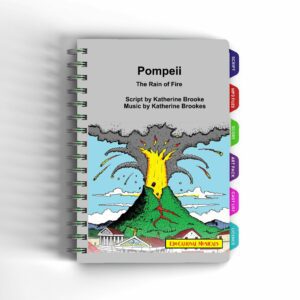
The city of Pompeii was a major resort city during the times of Ancient Rome. However, then everything changed when it was buried in volcanic dust in 79 AD, disaster struck the city when it was buried for 2,000 years under 20 feet of a blanket of ash and pumice when the nearby volcano, Mount Vesuvius, erupted.
The question is did they know they lived by a live volcano?
The question is did they know they lived by a live volcano?
But what was it like before the eruption?
Well, before the eruption Pompeii was a busy and lively city of 12,000 people that had a complex water system, an amphitheatre, gymnasium, a port and about 100 streets. The narrow streets had steppingstones high enough that even when it rained the citizens kept their feet dry, while they were low enough for carts to move around safely. We now know that due to how narrow they were, most of them were one-way streets.
The most important part of an Roman City was the forum, and, of course, Pompeii had one. It was from here that the business of the city, both political and economic, took place. Again, as with all Roman cities they also had temples to Venus, Jupiter, and Apollo, all of which were close to the forum.
Pompeii was an efficient city, it had an its own aqueduct to carry water into the city to the public baths and fountains. At the same time it meant that the wealthier residents had running water in their homes, a long time before we had it here!
Naturally, there were places for the arts and entertainment, along with an amphitheatre, where up to 20,000 people could watch the gladiator games.
The City
Pompeii was also a popular holiday destination for Romans. At this time it is thought that between 10,000 and 20,000 people lived there At the same time many wealthy Romans had summer homes in Pompeii and would live there during the hot summer months.
Earthquakes
The area around Pompeii experienced frequent earthquakes. In 62 AD there was a huge earthquake that destroyed many of the buildings of Pompeii. The city was still rebuilding seventeen years later when disaster struck.
The Volcano Erupts
On August 24, 79 AD Mount Vesuvius erupted. Scientists estimate that 1.5 million tons of ash and rock shot out of the volcano every second. The ash cloud likely towered over 20 miles high above the mountain. Some people managed to escape, but most didn’t. It is estimated that 16,000 people died.
Did they know what was coming?
The days prior to the eruption were recorded by a Roman administrator named Pliny the Younger. Pliny wrote that there had been several earth tremors in the days leading up to the eruption, but Roman science didn’t know that earthquakes could signal the start of a volcano erupting. Even when they first saw smoke rising from the top of the mountain, they were merely curious. They had no idea what was coming until it was too late.
A Great Archaeologists Find
The city of Pompeii was buried and gone. People eventually forgot about it. It wasn’t discovered again until the 1700s when archaeologists began to uncover the city. They found something amazing. Much of the city was preserved under the ashes. Buildings, paintings, houses, and workshops that it was assumed wouldn’t survive, did! The result of their discovery has told us a lot of what we now know of Roman life comes from Pompeii.
What we have now learnt about Pompeii
- The eruption happened a day after the religious festival to Vulcan, the Roman god of fire.
- The amount of energy released by the eruption was roughly one hundred thousand times the thermal energy released by the Hiroshima atomic bomb.
- The nearby city of Herculaneum was also destroyed.

We have published Pompeii – The Rain of Fire , which you can download at https://www.history-portal.com/index.php/product/pompeii/ where you can read two pages of script and listen to two of the songs.
Isn’t History fun?
10 questions to discuss:
- Did Pompeians have any warning signs of the approaching eruption beyond the earthquakes?
- How did the city’s infrastructure, like the aqueduct, impact daily life in Pompeii?
- What evidence has been found to suggest Pompeii was a popular holiday destination?
- Beyond the amphitheater, what other forms of entertainment were available in Pompeii?
- Given the frequent earthquakes, did the Pompeians have any disaster preparedness measures in place?
- How did Pliny the Younger’s account contribute to our understanding of the eruption’s timeline?
- Were there any survivors from the eruption, and if so, how did they escape?
- What specific Roman life details have been gleaned from Pompeii’s excavation that wouldn’t otherwise be known?
- Beyond the eruption, are there any other historical events or figures Pompeii helps us understand?
- What ethical considerations do archaeologists face when excavating and preserving a site like Pompeii?
To learn more go to:
© Tony Dalton


